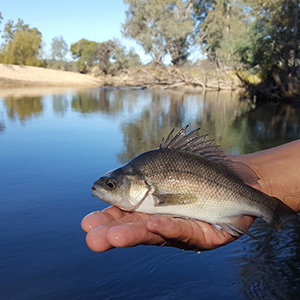Larval fish sensitivity to a simulated cold-water pulse varies between species and age

Accepted: 27 June 2022
Supplementary: 167
HTML: 135
All claims expressed in this article are solely those of the authors and do not necessarily represent those of their affiliated organizations, or those of the publisher, the editors and the reviewers. Any product that may be evaluated in this article or claim that may be made by its manufacturer is not guaranteed or endorsed by the publisher.
Authors
The release of cold-water from hypolimnetic zones of impoundments sharply reduces downstream riverine water temperature. This cold-water pollution (CWP) can extend for hundreds of kilometres, severely challenging the physiological ability of aquatic fauna, particularly ectotherms such as fish, to maintain essential processes such as metabolism, development and growth and survival. The impact of CWP on native fish, especially early life stages, is poorly known. We investigated the effect of a 24-hour exposure to a range of environmentally-related water temperatures (8, 10, 12, 14, 16, 18 and 20°C) on three age-classes (<24-hour-old, 7-day and 14-day-old larvae) of two Australian native fish species: Murray cod (Maccullochella peelii) and Macquarie perch (Macquaria australasica). Overall, larvae of M. peelii were more sensitive to lower water temperatures and hence CWP than M. australasica, indicated by higher rates of equilibrium loss. Larvae of M. peelii were most sensitive to exposure at seven days old whereas M. australasica larvae were most sensitive at <24-h-old. Using our results, we modelled pre- and post-impoundment temperature scenarios and estimated the downstream CWP footprint for both species in an Australian river reach. Larvae of M. peelii were predicted to be absent from the first 26 km of river downstream of the impoundment compared with no impact on the distribution of M. australasica. Managing riverine water temperature below impoundments is fundamental to promoting positive outcomes for endemic fish on not only a local, but global basis. This study emphasises the differential impact of CWP among the critical early life stages and fish species and highlights the urgent need to better manage hypolimnetic water releases to improve downstream river ecosystems.
Edited by
Pietro Volta, CNR-IRSA Verbania, ItalyHow to Cite

This work is licensed under a Creative Commons Attribution-NonCommercial 4.0 International License.
Similar Articles
- Jennifer K. Hellmann, Jeffrey S. Erikson, Simon A. Queenborough, Evaluating macroinvertebrate community shifts in the confluence of freestone and limestone streams , Journal of Limnology: Vol. 74 No. 1 (2015)
- Yuanfeng Cai, Fanxiang Kong, Diversity and dynamics of picocyanobacteria and the bloom-forming cyanobacteria in a large shallow eutrophic lake (lake Chaohu, China) , Journal of Limnology: Vol. 72 No. 3 (2013)
- Silvia Marková, Catia Maurone, Erica Racchetti, Marco Bartoli, Valeria Rossi, Daphnia diversity in water bodies of the Po River Basin , Journal of Limnology: Vol. 76 No. 2 (2017)
- Józef Piotr Girjatowicz, Małgorzata Świątek, Halina Kowalewska-Kalkowska, Relationships between air temperature and ice conditions on the southern Baltic coastal lakes in the context of climate change , Journal of Limnology: Vol. 81 (2022)
- Carolina Bustamante-Gil, Eduardo Amat, Andrés Boltovskoy, John J. Ramírez-Restrepo, The first floristic study of freshwater dinoflagellates (Dinophyceae) in Colombia , Journal of Limnology: Vol. 81 (2022)
- Michael Sturm, Elena G. Vologina, Svetlana S. Vorob’eva, Holocene and Late Glacial sedimentation near steep slopes in southern Lake Baikal , Journal of Limnology: Vol. 75 No. 1 (2016)
- Marlene S. Arcifa, Tânia C. dos Santos Ferreira, Claudia Fileto, Maria S. Maioli Castilho-Noll, Taís C. Bunioto, Walter J. Minto, A long-term study on crustacean plankton of a shallow tropical lake: the role of invertebrate predation , Journal of Limnology: Vol. 74 No. 3 (2015)
- Kathleen R. Laird, Biplob Das, Brittany Hesjedal, Peter R. Leavitt, Graham R. Mushet, Kenneth A. Scott, Gavin L. Simpson, Bjorn Wissel, Jared Wolfe, Brian F. Cumming, Paleolimnological assessment of nutrient enrichment on diatom assemblages in a priori defined nitrogen- and phosphorus-limited lakes downwind of the Athabasca Oil Sands, Canada , Journal of Limnology: Vol. 76 No. 3 (2017)
- Bárbara Becker, Bárbara de Oliveira Sanches Galhardo, Diego Rodrigues Macedo, Robert M. Hughes, Marcos Callisto, Gilmar B. Santos, Influence of limnological zones on the spatial distribution of fish assemblages in three Brazilian reservoirs , Journal of Limnology: Vol. 75 No. 1 (2016)
- Roberta Bettinetti, Letizia Garibaldi, Barbara Leoni, Silvia Quadroni, Silvana Galassi, Zooplankton as an early warning system of persistent organic pollutants contamination in a deep lake (lake Iseo, Northern Italy) , Journal of Limnology: Vol. 71 No. 2 (2012)
<< < 21 22 23 24 25 26 27 28 29 30 > >>
You may also start an advanced similarity search for this article.
-
John D. Koehn, Charles R. Todd, Henry Wootton, Michael JoyMarine and Freshwater Research : 2023

 https://doi.org/10.4081/jlimnol.2022.2056
https://doi.org/10.4081/jlimnol.2022.2056





